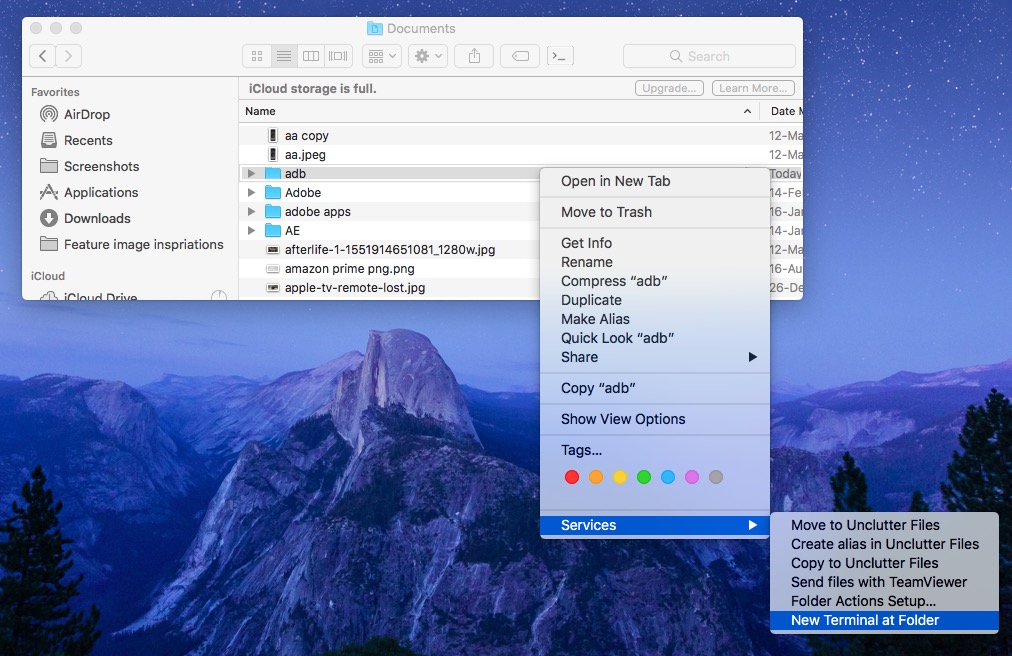

- #Finder open in terminal current folder full#
- #Finder open in terminal current folder windows 10#
- #Finder open in terminal current folder mac#
To do that you use the ls (or list) command. While you’re there-or when you’re in any folder ( directory in Unix-speak)-you might want to know what’s in it. When you first get to the command line, you’re in your home folder. The % is a character that the shell (the default interface that Terminal uses) displays to indicate that it’s ready to accept a command.(In the Finder, that’s the folder with your user name and the house icon.) Press Shift on your keyboard and Right Click on your mouse.
#Finder open in terminal current folder windows 10#
~ is a shortcut that means the current user’s Home folder. On your Windows 10 PC, open the folder you wish to open the command prompt within. Open a new profile instance To open a new terminal instance, in this case the command will open the profile named 'Ubuntu-18.04', enter: Command Prompt Windows Command Prompt wt -p 'Ubuntu-18.04' The -p flag is used to specify the Windows Terminal profile that should be opened.
#Finder open in terminal current folder mac#
Mac-Pro-8 is the name of the Mac (same as the Computer Name in the Sharing pane of System Preferences).Note that this cannot return a POSIX path if the frontmost window has no POSIX path. In the prompt above romansempire is the user name. The following command will return the path to the frontmost Finder window, if that's what you're looking for: osascript -e 'tell application 'Finder' to get the POSIX path of (target of front window as alias)'.The second line is the prompt, and while it can change from system to system depending on configuration, by default it contains several bits of information:.The first line shows the last time you logged into your Mac via the command line that’s the current time, when you’re using Terminal.More on these can be found in the video on top of the page. r is a "flag", allowing us to apply specific options to our comment. Using a very simple Automator workflow, you can create a Finder plug-in that lets you control-click on an object in the Finder and navigate to it in the Terminal.

Rm -r FolderName removes the folder including all files and folders it contains (in this case, the folder is also located in our current working directory) Removing directories which contain files and/or folders is possible, but must be done with caution as you can cause severe damage to your system when removing wrong files or folders. So be careful when applying these commands!

Important!: There is no way to bring back deleted files and folders. Alternatively, you can find and click Run on the Start menu. This will open the 'Run' tool in a new pop-up window. Hold down the Windows key on your keyboard, and press the 'R' button. Method 3 Using the Run Tool 1 Press Win + R on your keyboard. Rmdir FolderName removes the empty(!) folder in our current working directory This will open the Command Prompt or PowerShell terminal in a new window. Rm FileName.type removes the file referred to in the current folder (adding the path will delete the file in the respective folder) touch project/FileName.type.ĭeleting files or folders works as follows: Mkdir FolderName creates a new folder with the name specifiedīoth files and folders can also be created in specific directories when adding the corresponding path, e.g.
#Finder open in terminal current folder full#
Opening Current Directory in Finder using Terminal To open a specific directory, you have to type the full path of the directory next to the open command. pwd Figure out which directory you are currently in by Printing the Working Directory. Touch FileName.type will create a new (empty) file with the name and type specified To open the current directory in the Finder app, type the following command into the terminal and press enter: open. Basic Terminal Navigation Open up terminal, cmd + space terminal. Besides navigation, file and folder creation is also possible in the terminal:


 0 kommentar(er)
0 kommentar(er)
